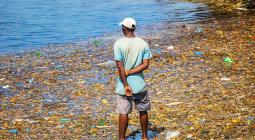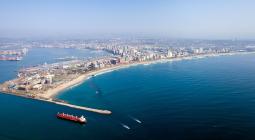Why the oceans are on the frontline of the climate crisis

Jervis Bay in Australia. Photograph: Cavan Images/Getty Images/iStockphoto
Good morning. The oceans are – according to the UN – “the world’s greatest ally against climate change”. While many of us now understand the urgent need to take the climate crisis seriously, the focus is still very much on the land and the air. Oceans cover more than 70% of the surface of the planet, generate 50% of the oxygen we breathe, absorb 25% of all carbon dioxide emissions and capture 90% of the excess heat generated by these emissions.
Perhaps it is time we stopped to think a bit more about our seas, consider the dangers they face and look at what we can do to help. Lisa Bachelor, who edits the Guardian’s Seascape series about the state of our oceans, has – if not all the answers – quite a few of them. She joins us after the headlines.
“The oceans have been very much the poor cousin compared to the land when it comes to reporting on the climate crisis, and we are trying to address this with dedicated coverage of oceans,” Lisa says. “There is a growing realisation that oceans are a massive carbon sink and a way for humanity to try and control the climate crisis. At the same time, oceans are under unprecedented threat – and this matters to both the wildlife and the people who rely on the sea.”
Despite the importance of our oceans – which provide half of the world’s oxygen, represent 95% of the planet’s biosphere and act as Earth’s largest carbon sink – they have very little, if any, legal protection.
Almost two-thirds of the world’s oceans lie outside national boundaries. These are the “high seas”, which had been essentially lawless until a treaty was signed at the UN last year in a “once in a lifetime” chance to at last protect the oceans. The new high seas treaty could also curb illegal and unregulated fishing. This widespread global activity depletes fish stocks, robs coastal communities of a vital food source and affects livelihoods, leading in some cases to human rights abuses.
When after almost two decades of talks the treaty was finally signed late on a Saturday night in 2023 at the UN headquarters in New York, Karen McVeigh, a Guardian Seascape reporter, was the only journalist in the room.
The historic treaty is crucial for enforcing the 30x30 pledge made by countries at a UN biodiversity conference, to protect a third of the sea (and land) by 2030. Without a treaty, this target would certainly fail, as until now no legal mechanism existed to set up marine protected areas on the high seas.
“The high seas treaty has been described as the most important treaty no one has ever heard of,” Lisa says. “And it should give protection to marine life and biodiversity for generations to come.”
The threats to our seas
While the treaty is good news, oceans are still threatened by pollution, plastics and the looming prospect of deep sea mining (pictured above). This is what it sounds like: mining ocean floor at depths greater than 200 metres for minerals, particularly those required for the batteries of electric cars.
“Vast areas of this unexplored abyss, particularly in the Pacific Ocean, are littered with polymetallic nodules, rich in manganese, nickel, copper, cobalt and other trace minerals. Minerals are also found near hydrothermal vents and within seamounts (underwater mountains),” Karen writes in this helpful explainer.
The surging demand for these minerals – and thus the need to mine the oceans – has been created by the rush to cut carbon emissions. In 2040, the world’s need for many of these metals– used for electric vehicle batteries, solar panels and wind turbines – will be twice what it is today, according to the International Energy Agency.
Supporters of deep sea mining argue that a huge expansion of mining on land would cause further environmental havoc: mining the sea floor is less destructive, they say. Critics say on-land mining will carry on and that deep sea mining will cause “irreversible harm” to marine life and systems.
Last year, the UK, Sweden and Ireland joined countries calling for a moratorium, pause or ban on commercial deep-sea mining. The 27 states involved include Germany, France, Spain, Brazil, New Zealand, Canada, Costa Rica, Chile, Panama, Palau, Fiji and the Federated States of Micronesia. Norway has approved deep-sea mining in its national waters.
What individuals can do
Beyond writing to politicians and signing petitions, there is not much we as individuals can do to make our views heard on deep sea mining. But there are other things we can do to help the oceans. “Sometimes it can feel overwhelming,” says Lisa. “But it’s not all grim news, and it’s not all out of our hands.”
Seascape has a series of articles on the British seaside and small things each of us can consider doing to play our part. You could join the Big Seaweed Search and help monitor seaweed biodiversity along the UK coastlines. There are also beach-cleaning operations across the country you can volunteer with, including Great Nurdle Hunters, who comb beaches for tiny bits of plastic, called nurdles.
When cooking, you could swap out cod and salmon for more unusual and sustainable seafoods (Pysk Fishmongers in Falmouth, pictured above, supply catch from local, small boats).
It is even possible to eat your way to improving biodiversity. In Sicily, people are being encouraged to eat invasive blue crabs. These crabs, with their striking blue claws and olive-green shells, are creating a crisis for Italy. Originating from the western Atlantic Ocean, they have no natural predators in the Mediterranean and feed on young clams, disrupting traditional shellfish harvests and affecting Italy’s position as one of the top clam producers in the world.
Francesco Tiralongo, a marine biologist at the University of Catania who has documented the explosive population growth of the blue crab, says in this piece: “Changing fish consumption habits in Sicily to include alien species like the blue crab is a necessary response to climate change and current ecological challenges.”
Editing Seascape has led Lisa to change her diet. “There is a huge feeling of guilt,” she says. “I am really cutting back on fish and seafood, and I am considering going back to being a vegetarian.”
Working on the series has also opened her eyes to a whole range of issues she hadn’t thought about before. “But the more I learn about the seas, the more positive I have become, because I have met and spoken to so many people who are completely dedicated to the future of our oceans.”





